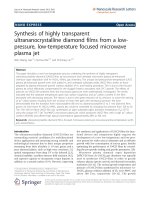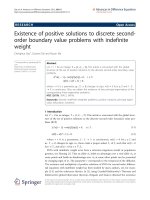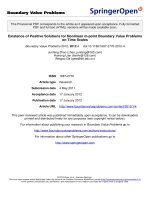Báo cáo toán học: " Existence of positive solutions to discrete secondorder boundary value problems with indefinite weight" pptx
Bạn đang xem bản rút gọn của tài liệu. Xem và tải ngay bản đầy đủ của tài liệu tại đây (350.72 KB, 10 trang )
RESEARCH Open Access
Existence of positive solutions to discrete second-
order boundary value problems with indefinite
weight
Chenghua Gao
*
, Guowei Dai and Ruyun Ma
* Correspondence: gaokuguo@163.
com
Department of Mathematics,
Northwest Normal University,
Lanzhou 730070, P. R. China
Abstract
Let T > 1 be an integer,
T
=
{
1, 2, , T
}
. This article is concerned with the global
structure of the set of positive solutions to the discrete second-order boundary value
problems
2
u(t − 1) + rm(t)f (u(t )) = 0, t ∈ T
,
u
(
0
)
= u
(
T +1
)
=0,
where r ≠ 0 is a parameter,
m :
T →
R
changes its sign, m(t) ≠ 0 for
t
∈ T
and f : ℝ
® ℝ is continuous. Also, we obtain the existence of two principal eigenvalues of the
corresponding linear eigenvalue problems.
MSC (2010): 39A12; 34B18.
Keywords: discrete indefinite weighted problems, positive solutions, principal eigen-
value, bifurcation, existence
1 Introduction
Let T > 1 be an integer,
T
=
{
1, 2, , T
}
. This article is concerned with the global struc-
ture of the set of positive solutions to the discrete second-order boundary value pro-
blem (BVP)
2
u
(
t − 1
)
+ rm
(
t
)
f
(
u
(
t
))
=0, t ∈ T
,
(1:1)
u
(
0
)
= u
(
T +1
)
=0
,
(1:2)
where r ≠ 0 is a parameter, f : ℝ ® ℝ is continuous, m(t) ≠ 0for
t
∈ T
and
m :
T →
R
changes its sign, i.e., there exists a proper subset
T
+
of
T
, such that m(t)>0
for
t ∈ T
+
and m(t) < 0 for
t ∈ T
\
T
+
.
BVPs with indefinite weight arise from a selection-migration model in population
genetics, see Fleming [1]. That an allele A
1
holds an advantage over a rival allele A
2
at
some points and holds an disadvantage over A
2
at some other points can be presented
by changing signs of m. The parameter r corresponds to the reciprocal of the diffusion.
The existence and multiplicity of positiv e solutions of BVPs for second-order differen-
tial equations with indefini te weight has been studied by many authors, see, for exam-
ple [2-5] and the references therein. In [2], using Crandall-Rabino witz’s Theorem and
Rabinowitz’s global bifurcation theorem, Delgado and Suárez obtained the existence
Gao et al. Advances in Difference Equations 2012, 2012:3
/>© 2012 Gao et al; licens ee Springer. This is an Open Access article di stributed under the terms o f the Creative Commons At tribution
License ( which permits unrestricted use, distribution, and reproduction in any medium,
provided the original work is properly cited.
and multiplicity of positive solutions under Dirichlet boundary value condition. In
2006, Afrouzi and Brown [3] also obtained the similar results by using the mountain
pass theorem. When f is concave-convex type, similar results were also obtained by
Ma and Han [4] and Ma et al. [5], and the main tool they used was the Ra binowitz’ s
global bifurcation theorem.
For the discrete case, there is much literature dealing with different equations similar
to (1.1) subject to various boundary value conditions. We refer to [6-14] and the refer-
ence therein. In particular, when m(t)>0on
T
, fixed point theorems, the discrete Gel-
fand theorem and the bifurcation techniques have been used to discuss the existence
of positive solutions to the discrete problems, see , for exa mple [6-8,12-14]. However,
there are few results on the existence of positive solutions of (1.1) and (1.2) when m(t)
changes its sign on
T
. Maybe the main reason is that the spectrum of the following lin-
ear eigenvalue problems
2
u
(
t − 1
)
+ λm
(
t
)
u
(
t
)
=0, t ∈ T
,
(1:3)
u(
0
)
= u
(
T +1
)
=
0
(1:4)
is not clear when m changes its sign on
T
.
It is another aim of our article to give some information of the spectrum of (1.3) and
(1.4). In this article, we will show that (1.3) and (1.4) has two principal eigenvalues l
m,-
<0<l
m,+
, and the corresponding eigenfunctions which we denote by ψ
m,-
and ψ
m,+
don’t change their signs on
T
. Based on this result, using Rabinowitz’s global bifurca-
tion theorem [15], we will discuss the global structure of the set o f positive solutions
of (1.1), (1.2), and obtain the existence of positive solutions of (1.1) and (1.2). More-
over, we can also obtain the existence of negative solutions of (1.1) and (1.2).
Now, we give the definition of a positive solution and a negative solution of (1.1) and
(1.2).
Definition 1.1. A positive solution of problem (1.1) and (1.2) refers to a pair (r, u),
where r ≠ 0, u is a solution of (1.1) with u >0on
T
and u satisfies (1.2). Meanwhilem
(r, u) is called a negative solution of (1. 1) and (1.2),if(r,-u) is a positive solution of
(1.1) and (1.2).
The article is arranged as follows. I n Section 2, we state the Rabinowitz’s global
bifurcation theorem. In Section 3, the existence of two principal eigenvalues of (1.3)
and (1.4) will be discussed. In Section 4, we state the main result and provide the
proof.
2 Preliminaries
For the readers’ convenience, we state the Rabinowitz’s global bifurcat ion theorem [15]
here.
Let E be a real Banach space. Consider the equation
u
= λTu + H
(
λ, u
)
,
(2:1)
which possesses the line of solutions {(l,0)|lÎℝ} henceforth referred to as the tri-
vial solutions, where T : E ® E is a bounded linear operator and H(l, u) is continuous
on ℝ × E with H(l, u)=o(༎ u ༎)nearu = 0 uniformly on bounded l intervals.
Gao et al. Advances in Difference Equations 2012, 2012:3
/>Page 2 of 10
Moreover, we assume that T and H are compact on E and ℝ × E, respectively, i.e., are
continuous and they map bounded sets into relatively compact sets.
we will say μ isacharacteristicvalueofT if there exists v Î E, v ≠ 0, such that v =
μTv,i.e.,μ
-1
is a nonz ero eigenvalue of T. Let r(T) denote the set of real characte ristic
values of T and Γ denote the closure of the set of nontrivial solutions of (2.1).
Theorem 2.1 ([15, Theorem 1.3]). If μ Î r(T) is of odd multiplicity, then Γ contains a
maximum subcontinuum
C
such that
(
μ,0
)
∈ C
and either
(i) meets ∞ in ℝ × E,
or
(ii) meets
(
˜μ,0
)
where
μ = ˜μ ∈ r
(
T
)
.
From [15], there exist two connected subsets,
C
+
and
C
−
,of
C
such that
C
=
C
+
∪
C
−
and
C
+
∩ C
−
= {
(
μ,0
)}
. Furthermore, Rabinowitz also shows that
Theorem 2.2 ([15, Theorem 1.40]). Each of
C
+
,
C
−
meets (μ,0)and either
(i) meets ∞ in ℝ × E,
or
(ii) meets
(
˜μ,0
)
where
μ = ˜μ ∈ r
(
T
)
.
3 Existence of two principal eigenvalues to (1.3) and (1.4)
Recall that
T
=
{
1, 2, , T
}
.Let
ˆ
T
=
{
0, 1, , T +1
}
.Let
X =
u :
ˆ
T → R|u(0) = u(T +1)=0
.ThenX is a Banach space under the norm
u
X
=max
t
∈
ˆ
T
u(t )
.Let
Y =
{
u
|
u : T → R
}
. Then Y is a Banach space under the norm
u
Y
=max
t∈T
u(t )
.
Define the operator L : X ® Y by
Lu
(
t
)
= −
2
u
(
t − 1
)
, t ∈ T
.
In this section, we will discuss the existence of principal eigenvalues for the BVP
(1.3) and (1.4). At first, we give the definition of principal eigenvalue of (1.3) and (1.4).
Definition 3.1. An eigenvalue l for (1.3) and (1.4) is called principal if there exists a
nonnegativ e eige nfunction correspondi ng to l, i.e., if there exists a nonnegative u Î X \
{0} such that (l, u) is a solution of (1.3) and (1.4).
The main idea we will use arises from [16,17]. For the reader’s convenience, we state
them here. At first, it is necessary to provide the definition of simple eigenvalue.
Definition 3.2. An eigenvalue l of (1.3) and (1.4) is called simple if dim
∞
n
=1
ker
I − λL
−1
n
=
1
, where kerA denotes the kernel of A.
Theorem 3.1. (1.3) and (1.4) has two simple principal eigenvalues.
Proof. Consider, for fixed l, the eigenvalue problems
Lu − λm
(
t
)
u
(
t
)
= μu
(
t
)
, t ∈ T
,
(3:1)
Gao et al. Advances in Difference Equations 2012, 2012:3
/>Page 3 of 10
u(
0
)
= u
(
T +1
)
=0
.
(3:2)
By Kelley and Peterson [18, Theorem 7.6], for fixed l, (3.1), and (3.2) has T simple
eigenvalues
μ
m,1
(
λ
)
<μ
m,2
(
λ
)
< ··· <μ
m,T
(
λ
),
and the corresponding eigenfunction ψ
m, k
(l, t) has exactly k - 1 simple generalized
zeros.
Thus, l is a principal eigenvalue of (1.3) and (1.4), if and only if μ
m,1
(l)=0.
On the other hand, let
S
m,λ
=
T
t=0
|φ(t)|
2
− λ
T
t=1
m(t ) φ(t)
2
: φ ∈ X,
T
t=1
φ(t)
2
=1
.
Clearly, S
m,l
is bounded below and μ
m,1
(l) = inf
jÎX
S
m,l
, see [18, Theorem 7.7].
For fixed
φ ∈ X, λ →
T
t
=
0
|φ(t)|
2
− λ
T
t
=1
m(t ) φ
2
(t
)
is an affine functio n and so a
concave function. As the infimum of any collection of concave functions is co ncave, it
fol lows that l®μ
m,1
(l) is a concave function. Also, by consi deri ng test functions j
1
,
j
2
Î X such that
T
t
=1
m(t ) φ
2
1
(t ) <
0
and
T
t
=1
m(t ) φ
2
2
(t ) >
0
, it is easy to see that
μ
m,1
(l ) ® -∞ as l®±∞. Thus, l®μ
m,1
(l) is an increasing function until it attains
its maximum, and is a decreasing function thereafter.
Since μ
m,1
(0) > 0, l®μ
m,1
(l) must have exactly two zeros. Thus, (1.3) and (1.4) has
exactly two principal eigenvalues, l
m,+
> 0 and l
m,-
< 0, and the corresponding eigen-
functions don’t change sign on
ˆ
T
.
Now, we give a property for the above two principal eigenvalues.
Theorem 3.2. If
m, m
1
: T →
R
change their signs, and m(t) ≤ m
1
( t) for
t
∈ T
, then
λ
m
1
,−
≤ λ
m,−
, λ
m
1
,+
≤ λ
m,
+
.
Proof. It can be seen that for l <0,
S
m,λ
≥ S
m
1
,
λ
,whichimplies
μ
m,1
(λ) ≥ μ
m
1
,1
(λ
)
and consequently,
λ
m,+
≥
λ
m
1
,
+
.
On the other hand, for l <0,
S
m,λ
≤
S
m
1
,
λ
, which indicates
μ
m,1
(λ) ≤ μ
m
1
,1
(λ
)
and
consequently,
λ
m,−
≥ λ
m
1
,−
.
4 Main result
We make the following assumptions.
(H1) f : ℝ ® ℝ is continuous and sf(s) > 0 for s ≠ 0.
(H2)
f
0
= lim
|s|→0
f (s)
s
∈ (0, ∞), f
∞
= lim
|s|→+∞
f (s)
s
∈ (0, ∞)
.
Theorem 4.1. Suppose that (H1) and (H2) hold Assume that
r ∈
λ
m,+
f
∞
,
λ
m,+
f
0
∪
λ
m,−
f
0
,
λ
m,−
f
∞
,
(4:1)
or
r ∈
λ
m,+
f
0
,
λ
m,+
f
∞
∪
λ
m,−
f
∞
,
λ
m,−
f
0
.
(4:2)
Gao et al. Advances in Difference Equations 2012, 2012:3
/>Page 4 of 10
Then (1.1) and (1.2) has two solutions u
+
and u
-
such that u
+
is positive on
T
and u
-
is negative on
T
.
Obviously, we can get the following lemma with ease.
Lemma 4.1. Suppose that u Î Xand
u
≡
0
on
T
satisfies (1.1) (or (1.3))andthere
exists
t
0
∈ T
such that u(t
0
)=0,then u(t
0
-1)u(t
0
+1)<0.
Proof of Theorem 4.1. First, we deal with the case r >0.
Let ζ, ξ Î C(ℝ, ℝ) such that
f (
u
)
=
f
0
u + ζ
(
u
)
,
f (
u
)
=
f
∞
u + ξ
(
u
).
Clearly
lim
|
u
|
→0
ζ (u)
u
= 0, lim
|
u
|
→∞
ξ( u)
u
=0
.
(4:3)
Let
˜
ξ (u)= max
0≤
|
s
|
≤u
|ξ(s) |
.
Then
˜
ξ
is nondecreasing and
lim
|
u
|
→∞
˜
ξ (u)
u
=0
.
(4:4)
Let us consider
Lu − λm
(
t
)
rf
0
u − λm
(
t
)
rζ
(
u
)
=0
,
(4:5)
as a bifurcation problem from the trivial solution u ≡ 0.
Equation (4.5) can be converted to the equivalent equation
u
(t )=λL
−1
m(·)rf
0
u(·)+m(·)rζ (u(·))
(t
)
:= λTu + H
(
λ, u
)
.
(4:6)
It is ea sy to see that T : X ® X is compact. Further we note that H(l, u)=lL
-1
[m
(·)ζ( u (·))] = o(༎u༎) near l = 0 uniformly on bounded l intervals, since
|
|L
−1
[m(·)ζ (u(·))]|| =max
t∈T
T
s=1
G(t , s)m(s)ζ (u(s))
≤ C · max
s∈
T
|m(s)|||ζ (u(·))||,
where
C =max
t
∈
ˆ
T
T
s=1
G(t , s
)
and
G(t , s)=
1
T +1
(T +1− t)s,0≤ s ≤ t ≤ T +1
,
(T +1− t)t,0≤ t ≤ s ≤ T +1
.
Let
E
=
R
×
X
under the product topology. Let
S
+
:= {u ∈ X|u
(
t
)
> 0fort ∈ T
}
. Set S
-
=-S
+
, S = S
+
∪ S
-
. Then S
+
and S
-
are disjoint in X. Finally let Ψ
±
= ℝ × S
±
and Ψ = ℝ
× S. Let Σ be the closure of the set of nontrivial solutions of (1.1) and (1.2).
It is easy to see that
λ
m,+
r
f
0
∈ r(T
)
is simple. Now applying Theorems 2.1 and 2.2, we
get the result as follows: Σ contains a maxim um subcontinuum
C
+
which is composed
of two distinct connected set
C
+
+
and
C
−
+
such that
C
+
= C
+
+
∪ C
−
+
and
Gao et al. Advances in Difference Equations 2012, 2012:3
/>Page 5 of 10
C
+
+
∩ C
−
+
=
λ
m,+
rf
0
,0
. Moreover, Lemma 4.1 guarantees the second case in Theo-
rems 2.1 and 2.2 cannot happen. Otherwise, there will exist
(η, y) ∈ C
v
+
,suchthaty has
a multiple zero point t
0
, (i.e., t
0
satisfies y(t
0
)=0andy(t
0
-1)y(t
0
+ 1) > 0). However,
this contradicts Lemma 4.1. Thus, for each
ν ∈{+, −}, C
ν
+
joins
λ
m,+
rf
0
,0
to infinity in
Ψ
v
and
C
ν
+
\
λ
m,+
rf
0
,0
⊂
ν
.
It is obvious that any solution to (4.5) of the form (1, u) yields a solution u to (1.1)
and (1.2). We will show that
C
ν
+
crosses the hyperplane {1} × X in ℝ × X.Toachieve
this goal, it will be enough to show that
λ
m,+
rf
∞
,
λ
m,+
rf
0
⊆ Proj
R
C
ν
+
,
(4:7)
or
λ
m,+
rf
0
,
λ
m,+
rf
∞
⊆ Proj
R
C
ν
+
,
(4:8)
where
Proj
R
C
ν
+
denotes the projection of
C
ν
+
on ℝ.
Let
μ
n
, y
n
∈ C
ν
+
satisfy
μ
n
+
||y
n
||
X
→∞
.
We note that μ
n
>0foralln Î N since (0,0) is the only s olution of ( 4.5) for l =0
and
C
ν
+
∩ ({0}×X)=
∅
.
Case 1.
λ
m,+
r
f
∞
< 1 <
λ
m,+
r
f
0
.
We divide the proof into two steps.
Step 1. We show that if there exists a constant number M > 0 such that
μ
n
∈
(
0, M]
,
(4:9)
then (4.7) holds.
In this case it follows that
|
|
y
n
||
X
→∞
.
(4:10)
We divide the equation
Ly
n
− μ
n
m
(
t
)
r
f
∞
y
n
− μ
n
m
(
t
)
rξ
(
y
n
)
=0
(4:11)
by ༎y
n
༎
x
and set
¯
y
n
=
y
n
||
y
n
||
X
.Since
¯
y
n
is bounded in X and μ
n
is bounded in ℝ,after
taking the subsequence if necessary, we have that
¯
y
n
→
¯
y
for some
¯
y
∈
X
with
||
¯
y
||
X
=
1
and
μ
n
→¯
μ
for some μ Î ℝ. Moreover, from (4.4) and the fact that
˜
ξ
is nondecreas-
ing, we have that
lim
n→∞
|ξ(y
n
(t ))|
y
n
X
=0
,
(4:12)
Gao et al. Advances in Difference Equations 2012, 2012:3
/>Page 6 of 10
since
|ξ(y
n
(t ))|
y
n
X
≤
˜
ξ( |y
n
(t ) |)
y
n
X
≤
ξ( y
n
X
)
y
n
X
. Thus,
¯
y(t)=
T
s
=1
G(t , s) ¯μm(s) rf
∞
¯
y(s)
,
which implies that
L
¯
y −¯μm
(
t
)
rf
∞
¯
y =0
.
(4:13)
We claim that
( ¯μ,
¯
y) ∈ C
ν
+
.
We only prove t hat if
y
n
∈
C
+
+
,then
¯
y
n
∈
C
+
+
. The other case that if
y
n
∈
C
−
+
,then
¯
y
n
∈ C
−
+
can be treated similarly.
Obviously when
y
n
∈ C
+
+
,then
¯
y
(
t
)
≥
0
on
ˆ
T
.Furthermore,
¯
y
(
t
)
> 0
on
T
.Infact,if
there exists a
t
0
∈
T
such that
¯
y
(
t
0
)
=
0
, then, by Lemma 4.1, we obtain
¯
y
(
t
0
− 1
)
¯
y
(
t
0
+1
)
<
0
which contradicts the fact that
¯
y
(
t
)
≥
0
on
ˆ
T
. Thus,
¯
y
(
t
)
> 0
on
T
. This together with the fact
C
+
is a closed set in
E
implies that
¯
y ∈
C
+
+
.Moreover,
¯μr
f
∞
= λ
m
,+
, so that
¯μ =
λ
m,+
r
f
∞
.
Thus, (4.7) holds.
Step 2. We show that there exists a constant M > 0 such that μ
n
Î (0, M] for all n.
Since {(μ
n
, y
n
)} are the solutions to (4.5), they follow that
Ly
n
= μ
n
rm
(
t
)
n
(
t
)
y
n
,
(4:14)
where
n
(t ):=
f (y
n
(t))
y
n
(
t
)
. From (H1) and (H2), there exist two positive constants r
1
and
r
2
, such that
ρ
1
<
f (y
n
)
y
n
<ρ
2
.
(4:15)
Let h
*
> 0 be the positive principal eigenvalue of the following linear eigenvalue pro-
blem
Lv = ηχ
1
(
t
)
m
(
t
)v
(4:16)
and h* >0thepositiveprincipaleigenvalueofthe following linear eigenvalue pro-
blem
Lv = ηχ
2
(
t
)
m
(
t
)
v
,
(4:17)
where
χ
1
(t )=
ρ
1
if m(t ) > 0, t ∈ T,
ρ
2
if m(t ) < 0, t ∈ T,
χ
2
(t )=
ρ
2
if m(t) > 0, t ∈ T,
ρ
1
if m(t) < 0, t ∈ T.
Gao et al. Advances in Difference Equations 2012, 2012:3
/>Page 7 of 10
By Theorem 3.2, (4.14), (4.15), (4.16), and (4.17), we get
η
∗
r
<μ
n
<
η
∗
r
.
Case 2.
λ
m,+
r
f
0
< 1 <
λ
m,+
r
f
∞
.
From Step 2 of Case 1, there exists M > 0 such that for all n Î N,
μ
n
∈
(
0, M]
.
Applying a similar argument to that used in Step 1 of Case 1 (after taking a subse-
quence and relabeling, if necessary), we get
μ
n
→
λ
m,+
r
f
∞
, y
n
→∞ as n →∞
,
which implies that (4.8) holds.
At last, we deal with the case r <0.
Let us consider
Lu − λrm
(
t
)
f
0
u − λrm
(
t
)
ζ
(
u
)
=0
,
(4:18)
as a bifurcation problem from the trivial solution u ≡ 0. Now, applying Theorems 2.1
and 2.2, we get the following results: Σ contains a maximum subcontinuum
C
−
which
is composed of two distinct connected set
C
+
−
and
C
−
−
such that
C
−
= C
+
−
∪ C
−
−
and
C
−
+
∩ C
−
−
=
λ
m,−
−rf
0
,0
. Moreover, by Lemma 4.1, for each
ν ∈
{
+, −
}
, C
ν
−
joins
λ
m,−
−rf
0
,0
to infinity in Ψ
v
and
C
ν
−
\
λ
m,−
−rf
0
,0
⊂
ν
,whereΣ and Ψ
v
are defined as in the case
r >0.
It is clear that any solution to (4.18) of the form (-1, u) yields a solutions u of (1.1)
and (1.2). We will show
C
ν
−
crosses the hyperplane {-1} × X in ℝ × X.Toachievethis
goal, it will be enough to show that
λ
m,−
−rf
∞
,
λ
m,−
−rf
0
⊆ Proj
R
C
ν
−
,
(4:19)
or
λ
m,−
−rf
0
,
λ
m,−
−rf
∞
⊆ Proj
R
C
v
−
.
(4:20)
Let
(
μ
n
, y
n
)
∈
C
ν
−
satisfy
|
μ
n
|
+
y
n
X
→∞
.
We note that μ
n
< 0 for all n Î N since (0, 0) is the only solution to (4.18) for l =0
and
C
ν
−
∩
(
{0}×X
)
=
∅
.
The rest of the proof is similar to the proof of the case r > 0, so we omit it.
5 Example
Let T = 5, then
T
=
{
1, 2, 3, 4, 5
}
. Consider the following discrete second-order BVPs
2
u
(
t − 1
)
+ λm
(
t
)
f
(
u
(
t
))
=0, t ∈ T
,
(5:1)
Gao et al. Advances in Difference Equations 2012, 2012:3
/>Page 8 of 10
u(
0
)
= u
(
6
)
=0,
(5:2)
where
m :
T →
R
which is defined by
m
(
1
)
=1, m
(
2
)
=2, m
(
3
)
=1, m
(
4
)
= −1, m
(
5
)
= −3
,
and
f (s)=
s
3
+ s
s
2
+2
.
By using Matlab 7.0, we get the following eigenvalue problem
2
u
(
t − 1
)
+ λm
(
t
)
u
(
t
)
=0, t ∈ T
,
(5:3)
u(
0
)
= u
(
6
)
=
0
(5:4)
has two principal eigenvalues l
m,-
= -0.5099 and l
m,+
= 0.2867. The corresponding
eigenfunctions
ψ
m,-
(t) and ψ
m,+
(t) satisfy
ψ
m,−
(0) = 0, ψ
m,−
(1) = 0.0471, ψ
m,−
(2) = 0.1182,
ψ
m,−
(
3
)
= 0.3099, ψ
m,−
(
4
)
= 0.6595, ψ
m,−
(
5
)
= 0.6729, ψ
m,−
(
6
)
=0
,
and
ψ
m,+
(0) = 0, ψ
m,+
(1) = 0.3867, ψ
m,+
(2) = 0.6626,
ψ
m,+
(
3
)
= 0.5584, ψ
m,+
(
4
)
= 0.2942, ψ
m,+
(
5
)
= 0.1143, ψ
m,+
(
6
)
=0
.
Moreover,
sf (s)=
s
4
+ s
2
s
2
+2
> 0, for s =0,
f
0
= lim
|
s
|
→0
f (s)
s
= lim
s→0
s
3
+ s
s
3
+2s
=
1
2
∈ (0, ∞), f
∞
= lim
|
s
|
→∞
f (s)
s
= lim
s→∞
s
3
+ s
s
3
+2s
=1∈ (0, ∞)
.
Obviously, f(s) satisfies (H1) and (H2). Thus, for
r ∈
(
λ
m,+
,2λ
m,+
)
or
r ∈
(
2λ
m,−
, λ
m,−
,
),
(5.1) and (5.2) has a positive solution u
+
and a negative solution u
-
.
Acknowledgements
The authors were very grateful to the anonymous referees for their valuable sugges tions. This research was supported
by the National Natural Science Foundation of China (No. 11061030, 11101335,11126296) and the Fundamental
Research Funds of the Gansu Universities.
Authors’ contributions
The authors declare that the study was realized in collaboration with the same responsibility. All authors read and
approved the final manuscript.
Competing interests
The authors declare that they have no competing interests.
Received: 14 August 2011 Accepted: 17 January 2012 Published: 17 January 2012
Gao et al. Advances in Difference Equations 2012, 2012:3
/>Page 9 of 10
References
1. Fleming, WH: A selection-migration model in population genetics. J Math Biol.2(1975), 219–233
2. Delgado, M, Suárez, A: On the existence and multiplicity of positive solutions for some indefinite nonlinear eigenvalue
problem. Proc Amer Math Soc. 132(6), 1721–1728 (2004). doi:10.1090/S0002-9939-04-07233-8
3. Afrouzi, GA, Brown, KJ: Positive mountain pass solutions for a semilinear elliptic equation with a sign-changing weight
function. Nonlinear Anal: TMA. 64, 409–416 (2006). doi:10.1016/j.na.2005.06.018
4. Ma, RY, Han, XL: Existence and multiplicity of positive solutions of a nonlinear eigenvalue problem with indefinite
weight function. Appl Math Comput. 215, 1077–1083 (2009). doi:10.1016/j.amc.2009.06.042
5. Ma, RY, Xu, J, Han, XL: Global bifurcation of positive solutions of a second-order periodic boundary value problems with
indefinite weight. Nonlinear Anal: TMA. 71, 2119–2125 (2009). doi:10.1016/j.na.2009.01.046
6. Agarwal, RP, Henderson, J: Positive solutions and nonlinear eigenvalue problems for third order difference equations.
Comput Math Appl. 36(10-12), 347–355 (1998). doi:10.1016/S0898-1221(98)80035-7
7. Agarwal, RP, O’Regan, D: Boundary value problems for discrete equations. Appl Math Lett. 10(4), 83–89 (1997).
doi:10.1016/S0893-9659(97)00064-5
8. Atici, FM, Guseinov, GSh: On the existence of positive solutions for nonlinear differential equations with periodic
boundary conditions. J Comput Appl Math. 132(2), 341–356 (2001). doi:10.1016/S0377-0427(00)00438-6
9. Rachunkova, I, Tisdell, CC: Existence of non-spurious solutions to discrete Dirichlet problems with lower and upper
solutions. Nonlinear Anal: TMA. 67(4), 1236–1245 (2007). doi:10.1016/j.na.2006.07.010
10. Rodriguez, J: Nonlinear discrete Sturm-Liouville problems. J Math Anal Appl. 308(1), 380–391 (2005). doi:10.1016/j.
jmaa.2005.01.032
11. Cheng, SS, Yen, HT: On a discrete nonlinear boundary value problem. Linear Algebra Appl. 313(1-3), 193–201 (2000).
doi:10.1016/S0024-3795(00)00133-6
12. Zhang, G, Feng, W: On the number of positive solutions of a nonlinear algebraic system. Linear Algebra Appl. 422(2-3),
404–421 (2007). doi:10.1016/j.laa.2006.10.026
13. Ma, RY, Ma, HL: Positive solutions for nonlinear discrete periodic boundary value problems. Comput Math Appl. 59,
136–141 (2010). doi:10.1016/j.camwa.2009.07.071
14. Ma, RY, Xu, YJ, Gao, CH: A global description of the positive solutions of sublinear second-order discrete boundary
value problems. Adv Diff Equ, Art ID 671625. 15 (2009)
15. Rabinowitz, PH: Some global results of nonlinear eigenvalue problems. J Funct Anal. 7, 487–513 (1971). doi:10.1016/
0022-1236(71)90030-9
16. Hess, P, Kato, T: On some linear and nonlinear eigenvalue problems with indefinite weight function. Comm Part Diff
Equ. 5, 999–1030 (1980). doi:10.1080/03605308008820162
17. Afrouzi, GA, Brown, KJ: On principal eigenvlaues for boundary value problems with indefinite weight and Robin
boundary conditions. Proc Amer Math Soc. 127(1), 125–130 (1999). doi:10.1090/S0002-9939-99-04561-X
18. Kelly, W, Peterson, A: Difference Equations. An Introduction with Applications. Academic Press, New York (1990)
doi:10.1186/1687-1847-2012-3
Cite this article as: Gao et al.: Existence of positive solutions to discrete second-order boundary value problems
with indefinite weight. Advances in Difference Equations 2012 2012:3.
Submit your manuscript to a
journal and benefi t from:
7 Convenient online submission
7 Rigorous peer review
7 Immediate publication on acceptance
7 Open access: articles freely available online
7 High visibility within the fi eld
7 Retaining the copyright to your article
Submit your next manuscript at 7 springeropen.com
Gao et al. Advances in Difference Equations 2012, 2012:3
/>Page 10 of 10









